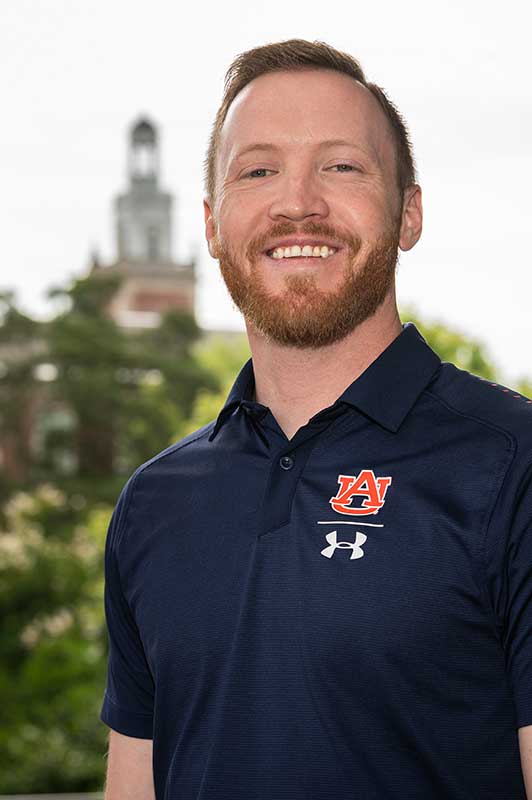Engineered to win: Auburn iRacing team evolves from fledgling student organization into powerhouse
Published: Apr 22, 2025 11:00 AM
By Joe McAdory
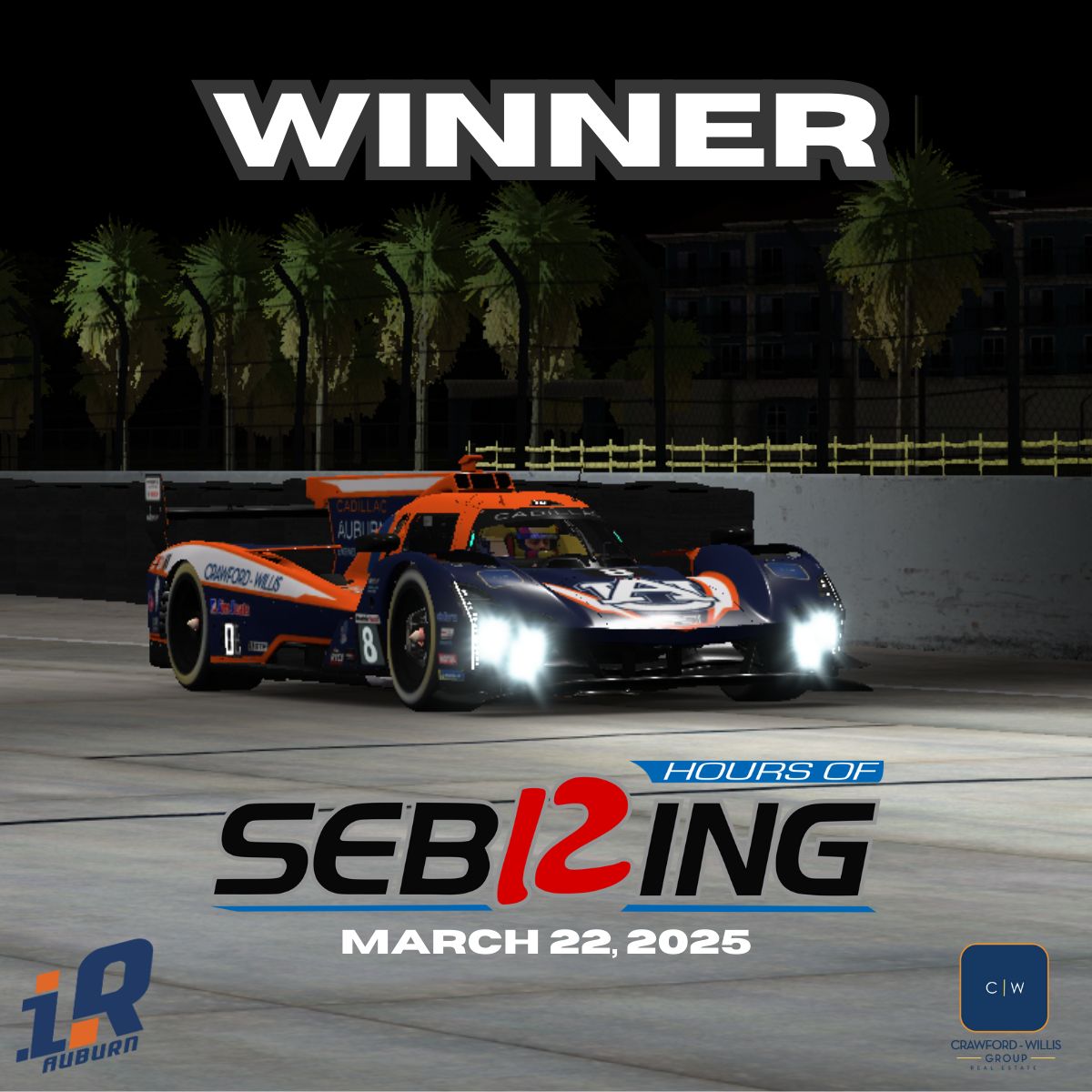
Team Penske. Ganassi Racing. Hendrick Motorsports… Auburn iRacing?
Auburn University’s official iRacing team has evolved from a fledgling student organization three years ago to one that’s putting Auburn Engineering alumni into important positions within the professional racing industry.
The 33-member team took another step forward on March 22 by winning the 12 Hours of Sebring’s GTP Class, one of iRacing’s crown jewel events.
Stuart McFall (materials engineering), Pierce Sealey (mechanical engineering) and Reece Baham (mechanical engineering alumnus) split 14 driving shifts over 377 laps in a simulated Cadillac GTP prototype on virtual Sebring International Raceway’s 3.4-mile, 17-turn layout — finishing five laps ahead of second place in the 59-car field.
“We’ve come a long way from a group of students who shared a plastic Logitech steering wheel and pedal set into a competitive organization,” said Andrew McGill, Auburn iRacing adviser and manager of engineering recruitment within the Samuel Ginn College of Engineering. “Winning at Sebring raises the bar.”
Engineered to win
iRacing is a subscription-based, server-connected realistic online racing simulator used by both professionals and enthusiasts to compete in virtual motorsport events at dozens of real-life venues. It features laser-scanned tracks, accurate physics and organized races that closely mirror real-world racing, including NASCAR, IndyCar, the International Motor Sports Association and more.
But don’t think engineering principles aren’t involved.
Should the rear springs be firm or soft? Do the front wheels have too much camber? What about ride height? Will long-term speed be gained if the car is set lower to the ground? If so, how much? Engineering know-how plays a major role in the design of everyday auto mechanics — and is measured by performance.
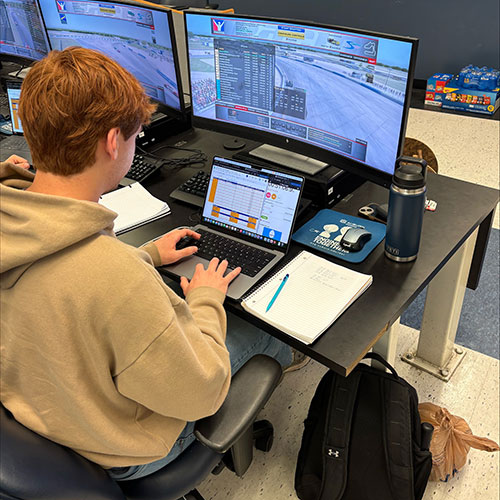
“In terms of engineering principles needed to prepare for a simulated car race, the general skills and knowledge needed for our drivers are a good theoretical understanding of vehicle dynamics, how to set up a car for a track and basic race strategy,” said Jack Crofoot, a junior in industrial and systems engineering and the Auburn iRacing director of competition.
“Auburn University has taught me everything I need to know about data analysis, data collection, simulation and stochastic operations. Knowing how and why certain changes to the car affect its performance allows our drivers to set up their own cars in a way that maximizes performance.”
Crofoot said data collected by the team’s race engineers will be used to build simulation software to replicate different scenarios and develop more in-depth strategies for future races.
Speaking of race engineers, how do they contribute?
“Drivers work closely with the race engineers to monitor fuel and make sure we bring the car into the pits right before it runs out of gas,” Crofoot said. “Throughout the race, race engineers collect data on tire wear, fuel usage, lap times, etc. This data allows race engineers to advise drivers on their performance based on data.”
Via radio, race engineers offer race and track updates, spot for traffic and offer pit stop suggestions.
Gavin Scheu, a sophomore in computer science and software engineering, hadn’t served as a race engineer until the green flag flew at Sebring. After the checkered flag fell in the Cadillac GTP Class, he’s 1-for-1. Other race engineers at Sebring included Joshua Blunt, a sophomore in mechanical engineering, and Andrew Phelps, a freshman in computer science.
Auburn Engineering bridges the gap
Auburn Engineering’s foray into the racing world doesn’t end when the simulator is shut down.
- Autonomous Tiger Racing, a product of the college’s GPS and Vehicle Dynamics Laboratory, developed the first autonomous race car, a Dallara AV-21, to turn laps and make a fully autonomous pit stop at Indianapolis Motor Speedway.
- Founded in 1995, War Eagle Motorsports features a formula SAE racing team and tackles asphalt circuits.
- Auburn Off-Road designs, builds and races off-road vehicles in the Baja SAE collegiate design series.
- Auburn University Autosport is a student organization that prepares competition-ready endurance cars.
- Auburn Engineering's Greenpower USA team (electric-powered cars), an initiative of the college's Introduction to Motorsports Engineering course (ENGR 1110), collaborates with Inspire Academy in Chambers County through senior design projects to improve performance. The team will compete for the Greenpower USA national championship at Talladega Superspeedway on May 2-3. Jordan Roberts, senior lecturer, undergraduate program officer and student advisor in the Department of Mechanical Engineering, said the team hopes to use this endeavor as a pathway for students to get involved in other motorsports within the college.
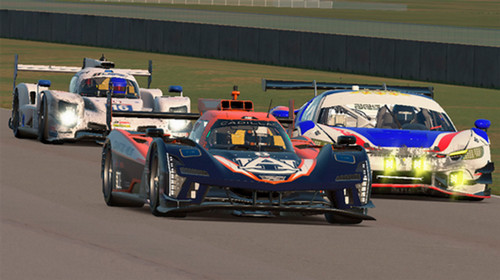
“Our engineering program is dedicated to providing students with a comprehensive and dynamic education that bridges the gap between theoretical knowledge and practical application,” said Dean Hendrix, associate dean for undergraduate studies and program assessment. “College initiatives in the motorsports world allow students to engage with the latest advancements in vehicle technology, honing their skills in a highly competitive and innovative environments.
“As with all these experiential learning opportunities, we are excited for the growth of our iRacing program. This platform offers students the unique opportunity to apply engineering principles in a simulated racing environment, mirroring the challenges and demands of real-world racing. Through iRacing, students gain invaluable experience in vehicle dynamics, race strategy and performance optimization, all of which are critical for successful careers in the motorsports industry.”
‘Keep the car on track’
Four-time Indianapolis 500 champion Rick Mears once said, “To finish first, you must first finish.” Auburn iRacing got the message.
“The biggest thing we told our drivers pre-race was that as long as you keep the car driving and on track, even if you're five seconds slower per lap, there's a good chance you'll end up on the podium (top three),” said Grant Meder, a senior in pro flight. “I said, ‘we're fast enough to win. We just need to keep the car on track.’ They did a great job of being super consistent. They didn't qualify up front but stayed out of traffic and halfway through the race, they were sitting pretty.”
McFall climbed back into the driver’s seat and assumed command of the team’s Cadillac GTP Prototype with two hours remaining, nursing a 30-second lead.
“I knew that to win, I had to maintain that gap without pushing the car too hard,” McFall said. “The other team’s fastest driver was going to be in the car for the final two hours, so I knew I had my work cut out for me.”
‘We could taste victory’
Nerves inside the team’s Wiggins Hall makeshift race “war room” grew tall as race engineers and teammates watched the final moments unfold.
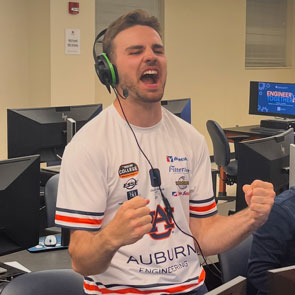
“Our car was in first place, but we needed to stay on track and finish the race,” McGill said. “Each time we encountered traffic, I grew nervous, thinking, ‘Oh my gosh, don't hit anything.’”
He didn’t.
“We watched as the second-place GTP plowed straight into a GT3 class car and was essentially out of the race,” McFall said. “This took a large weight off my shoulders and allowed me to fuel save and drive safely within the limits of the car. The next two hours changed from maintaining the gap to keeping the car on track.
“In the last 15-20 minutes of the race, I was imagining the win. When I crossed the finish line, I heard all the race engineers cheering and clapping and it felt great. It really felt like a team effort, and I couldn’t have done it without my other two drivers and race engineer.”
Auburn’s second GTP team (Meder, Zack Wainwright, Pierce Hanley and Jason Satterlee) finished ninth.
The team’s LMP2 car (a Lemans prototype) piloted by Spencer Black, Turner Brook, Nathan Roth and Mitchell Stockton, finished seventh in class.
‘That’s my dream’
Two Auburn iRacing alums, Baham and Raegen Moody already have full-time gigs in the racing industry.
Moody, a mechanical engineering alumna who served as a race engineer on the organization’s first team, is a shop engineer at JR Motorsports, a race organization owned by Dale Earnhardt Jr. that fields a fleet of Chevrolets in NASCAR’s Xfinity Series.
Baham is an applied vehicle dynamics support engineer at General Motors and works closely with driving simulators for Andretti Global’s F1 exploits.
Weeks after establishing the student organization, McGill brought the inaugural team to Barber Motorsports Park to view the IndyCar Series’ Children’s of Alabama Grand Prix and view race engineers prepare real-life race cars for combat.
“That morning at Barber, a team member from McLaren asked me about my vision for Auburn iRacing,” McGill said. “I said my vision was to walk the paddock (garage area) in four or five years and see former Auburn students working with these teams.
“We have many students who want to work in this industry. This is their opportunity to get prepared for what lies ahead where they can provide real answers in job interviews about managing tire degradation, fuel calculations, handling accidents and redoing strategies. They can say, 'I've done this before.'
“That's my dream."
Media Contact: , jem0040@auburn.edu, 334.844.3447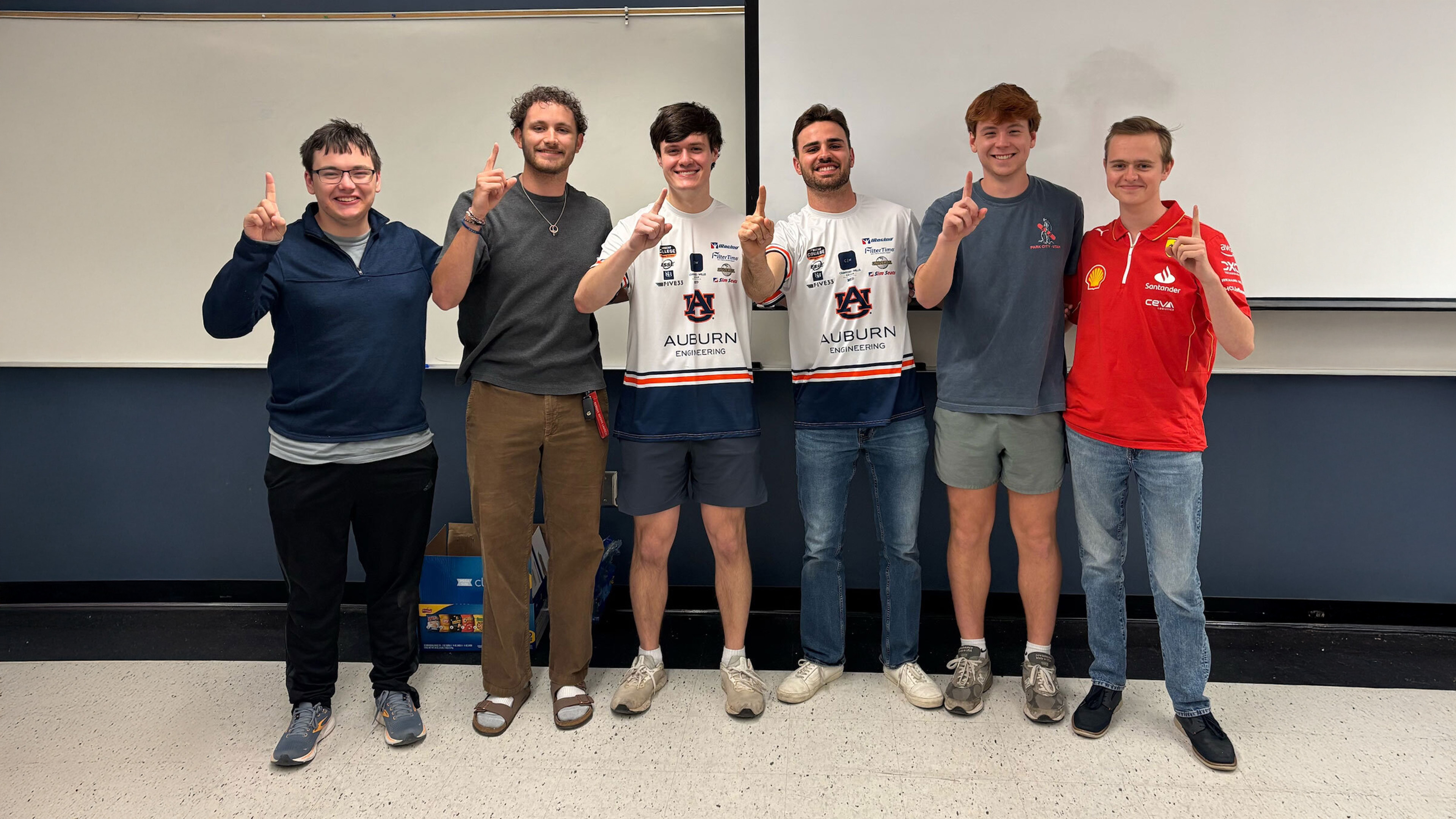
Celebrating Auburn iRacing's success on the night of March 22 are, from left, Andrew Phelps (race engineer for LMP2), Stephen Russell (director of marketing), Grant Meder (president), Jack Crofoot (director of competition), Gavin Scheu (race engineer for race-winning GTP No. 2 team) and Spencer Black (LMP2 driver).


